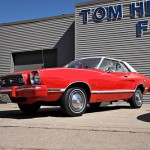I recently met with Joe Saul-Sehy to talk about his new money podcast, Stacking Benjamins, which debuts this week. We had just finished recording his final Two Guys and Your Money show, and I figured it would be clever to conduct the interview via ...
Continue reading A Fun Interview with Stacking Benjamins’ Host, Joe Saul-Sehy
More Reasons Why I Decided to Buy a New Car Instead of a Used One
As I mentioned in my previous post, I finally relented and bought myself a new car.
I can understand why some of you may be scratching your head at my decision to buy new instead of used. Especially when the playbook of good personal finance ...
Continue reading More Reasons Why I Decided to Buy a New Car Instead of a Used One
I Finally Broke Down and Bought a New Car
OK, I did it.
After commuting to and from work in my 1997 Honda Civic for the past 13 years, and with my son on the verge of getting his driver's license, I finally relented and bought myself a new car.
That's right. I'm now the proud owner of ...
Continue reading I Finally Broke Down and Bought a New Car
How to Get the Best Travel Deal from Price Comparison Websites
Price comparison websites are a great resource for budget-conscious travelers, with many people skipping travel agents altogether and doing the flight booking themselves. Due to the huge growth in this type of website, there are now more price ...
Continue reading How to Get the Best Travel Deal from Price Comparison Websites
A Small Victory in My Quest to Raise Financially Literate Kids
Teaching kids about personal finance is not an easy job. Even so, as a parent I believe it is my responsibility to ensure that my kids have a thorough understanding of good personal finance practices before they leave the nest.
Ultimately it will ...
Continue reading A Small Victory in My Quest to Raise Financially Literate Kids
Why Bag Ladies are Financially Savvier Than Many Celebrities
Grammy Award winner Dionne Warwick, who found fame in the 1960s singing "Do You Know the Way to San Jose?" filed for bankruptcy yesterday.
Younger folks may recognize Warwick from the 1990s, when she was the celebrity spokesperson for the Psychic ...
Continue reading Why Bag Ladies are Financially Savvier Than Many Celebrities
How I Stupidly Got Ripped Off by Not Getting Multiple Estimates
Whether we realize it or not, we manage financial risk whenever we take the time to get multiple price estimates from competing contractors. Those who do often get rewarded for their efforts.
As for those who don't, well ... they often end up ...
Continue reading How I Stupidly Got Ripped Off by Not Getting Multiple Estimates
Economic Collapse 101: What It Will Look Like, and How It May Start
It takes courage to face the bogeyman.
I bet many of the good folks in Great Falls, Montana, were more than a little worried earlier this month after a local television station there sent out an ominous message warning viewers that the dead were ...
Continue reading Economic Collapse 101: What It Will Look Like, and How It May Start
9 ‘Oops’ Moments That I Ultimately Paid For (One Way or Another)
Last week I needed to venture into my attic to check on some rat traps, so I grabbed my flashlight to help me navigate my way through the rafters. As luck would have it, the flashlight wasn't working; the last person who used it forgot to turn the ...
Continue reading 9 ‘Oops’ Moments That I Ultimately Paid For (One Way or Another)
The Unconventional Wisdom of Household Strategic Planning
My son, Matthew, is quickly approaching his 16th birthday and so I've been giving him a few driving tutorials.
I haven't let him get behind the wheel just yet -- that's on next month's agenda -- but it's gotten to the point now where every time ...
Continue reading The Unconventional Wisdom of Household Strategic Planning
The Best Credit Cards of 2013
This is a guest post by Logan Abbott. Logan is the editor of MyRatePlan.com, a leading comparison site for credit cards, mobile phones, phone service, insurance, and more.
The New Year is upon us, and that means you probably made some New Year's ...
Continue reading The Best Credit Cards of 2013
Looking Back at My Magic 8-Ball’s Predictions for 2012
For the past three years, I've been using my trusty Magic 8-Ball to predict the future. I know.
Laugh all you want, folks, but it's been quite successful over the years. In 2010, my Magic 8-Ball had an astounding 70% success rate. The following ...
Continue reading Looking Back at My Magic 8-Ball’s Predictions for 2012
Save Money: In-School or Going Back
Whether you're starting college for the first time, or going for a different degree years later, you should look for ways that you can save money during college. College is a great expense and many people incur thousands of dollars of debt in student ...
Continue reading Save Money: In-School or Going Back
Essential Tips for Lowering Your Grocery Bill (Part 3)
This is final post in my three-part series outlining essential tips that the Penzo household follows for keeping our grocery bills under control.
Of course, there are many methods for cutting the grocery bill that go way beyond shopping at ...
Continue reading Essential Tips for Lowering Your Grocery Bill (Part 3)
Essential Tips for Lowering Your Grocery Bill (Part 2)
Food isn't cheap.
Want proof? Then chew on this: I spent almost $12,000 in groceries last year for my four-person family, including two teenagers.
And what's really scary is that I work very hard to keep my food bill as low as possible every ...
Continue reading Essential Tips for Lowering Your Grocery Bill (Part 2)
Essential Tips For Lowering Your Grocery Bill
One of the big reasons the Honeybee has tolerated me for so long is because I love to cook. Some of you fellas out there would be wise to keep that in mind.
Why is that, you ask? Well, it's somewhat ironic, but the fact remains, the more time men ...
Continue reading Essential Tips For Lowering Your Grocery Bill
100 Words On: How Smart People Make High Risk Ventures Pay Off
Risk and reward are inextricably intertwined. Of course, the richest rewards come to those who are willing to take the biggest risks. The oft-forgotten corollary to that strategy is that, by its very nature, high risk endeavors also have a greater ...
Continue reading 100 Words On: How Smart People Make High Risk Ventures Pay Off
Why Financial Success Often Depends on the Road Not Taken
Decisions, decisions. Like it or not, our lives are defined by them.
It's no secret that a big part of our financial success is based upon the decisions we make in life.
Just ask any person who has jeopardized their financial future by, say, ...
Continue reading Why Financial Success Often Depends on the Road Not Taken
15 Reasons Why Waterbeds Are For Suckers
Sometimes people buy things that they eventually end up regretting. I know I've got a long list.
I've already explained why corner lots and whirlpool tubs are for suckers.
Today, I've got two words for anybody out there who is currently ...
Continue reading 15 Reasons Why Waterbeds Are For Suckers
Why I Refuse to Get Upset By Subtly Deceptive Advertising
Last weekend I was lured to an online calendar website with the following promise: "Everything up to 60% off!"
Sixty percent!
While I was visiting there I found a calendar that was on sale for $13.49 -- $1.50 off the regular price of ...
Continue reading Why I Refuse to Get Upset By Subtly Deceptive Advertising
- « Previous Page
- 1
- …
- 139
- 140
- 141
- 142
- 143
- …
- 150
- Next Page »



















